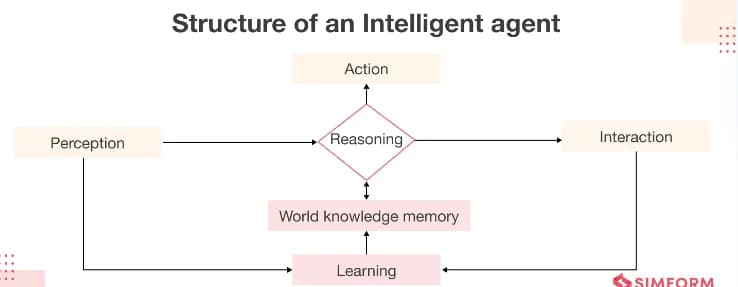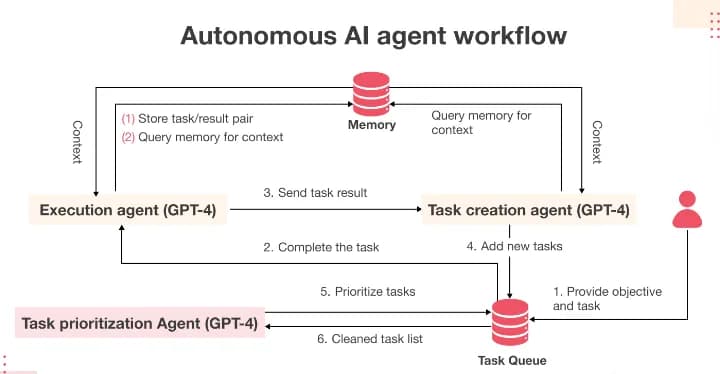The article answered the most frequent asked AI agent questions.
Table of contents
Open Table of contents
What is AI agent?
An AI agent is a software program designed to interact with its environment, perceive the data it receives, and take actions based on that data to achieve specific goals. AI agents simulate intelligent behavior, and they can be as simple as rule-based systems or as complex as advanced machine learning models. They use predetermined rules or trained models to make decisions and might need external control or supervision.
Both AI tools and AI agents can perform tasks autonomously to an extent. So what sets them apart? What qualifies an AI tool as an agent? Let’s find out!
- Autonomy: An AI virtual agent is capable of performing tasks independently without requiring constant human intervention or input.
- Perception: The agent function senses and interprets the environment they operate in through various sensors, such as cameras or microphones.
- Reactivity: An AI agent can assess the environment and respond accordingly to achieve its goals.
- Reasoning and decision-making: AI agents are intelligent tools that can analyze data and make decisions to achieve goals. They use reasoning techniques and algorithms to process information and take appropriate actions.
- Learning: They can learn and enhance their performance through machine, deep, and reinforcement learning elements and techniques.
- Communication: AI agents can communicate with other agents or humans using different methods, like understanding and responding to natural language, recognizing speech, and exchanging messages through text.
- Goal-oriented: They are designed to achieve specific goals, which can be pre-defined or learned through interactions with the environment. The structure of AI agent:

How does AI agent work

Agent Types
| Agent types | Decription | Example |
|---|---|---|
| simple reflex agent | ||
| model based reflex agent | ||
| goal based agent | ||
| utility based agent | ||
| learning agent |
Agent Systems
| Agent system | Decription | Example |
|---|---|---|
| single | ||
| multi | ||
| hierarchy |
What is the difference between AI agent and interaction with GPT?
Right now, interacting with AI follows a familiar ritual. You enter a prompt, and the AI model calculates a response based on the input. Every time you want a new output, you have to provide a prompt. There’s always a human to start the process.
AI agents work in a different way. They’re designed to think and act independently. The only thing you have to provide is a goal—be that researching competitors or buying a pizza. They’ll generate a task list and get to work, relying on feedback from the environment and their own internal monologue. It’s as if the AI agents can prompt themselves, constantly evolving and adapting to achieve their objective in the best way possible.
What is the difference between AI agent and workflow automation?
When compared with mainstream automation—where you set up a range of triggers based on data or system states and configure what happens next—AI agents can work in unpredictable environments where there’s a lot of new information. It’s artificially intelligent automation.
AI agents can use computers extremely well, too. They can browse the web, use apps, read and write files, make payments with your credit card, and even control your laptop as they do so.
For workflow automation, you need to specify each task, but AI agent will ask on your goal, create tasks, set priorities, and evaluate the results based on env or monologue.
The steps to create an AI agent?
When you input your objective, the AI agent goes through goal initialization. It passes your prompt to the core LLM (the ones used now are GPT-3.5 and GPT-4), and returns the first output of its internal monologue, displaying that it understands what it needs to do.
The next step is creating a task list. Based on the goal, it’ll generate a set of tasks and understand in which order it should complete them. Once it decides that it has a viable plan, it’ll start searching for information.
Since the agent can use a computer the same way you do, it can gather information from the internet. I’ve also seen some agents that are able to connect with other AI models to outsource tasks and decisions, letting them access image generation, geographical data processing, or computer vision features.
All data is stored and managed by the agent, both so it can relay it back to you and so it can improve its strategy as it moves forward.
As tasks are crossed off the list, the agent assesses how far it still is from the goal by gathering feedback, both from external sources and from its internal monologue.
And until the goal is met, the agent will keep iterating, creating more tasks, gathering more information and feedback, and moving forward without pause.
This describes the general steps that a conventional AI agent can take to complete any goal. But depending on how developers set up their agents, the steps may be organized differently. This also only describes agents we use on our computers or on a software platform—there are other kinds of AI agents that we’ll explore next.
What is the difference between LLM and AI agent
A language model is a specific type of AI agent focused on understanding and generating human language. It excels in tasks related to natural language processing and text generation, making it a valuable tool for various applications, including chatbots and content creation.
How to train an LLM?
Do I need to train an LLM or use chatgpt?
In short, do not